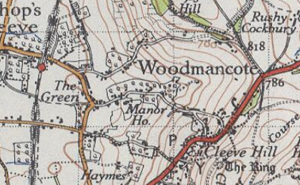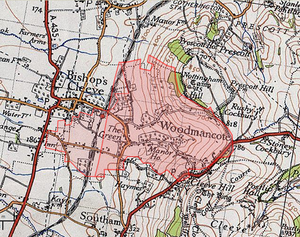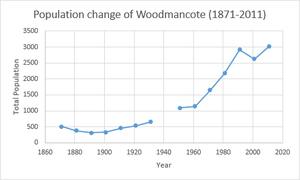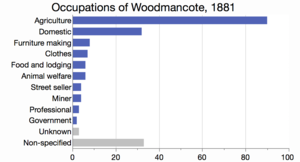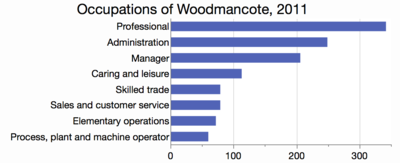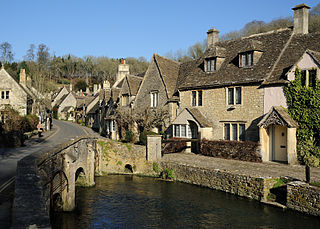
The Cotswolds is a region in central-southwest England, along a range of rolling hills that rise from the meadows of the upper Thames to an escarpment above the Severn Valley and Evesham Vale.

Gloucestershire is a county in South West England. The county comprises part of the Cotswold Hills, part of the flat fertile valley of the River Severn and the entire Forest of Dean.
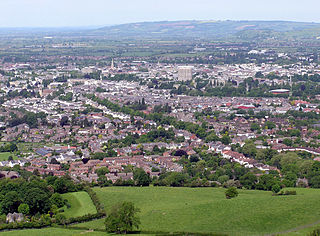
Cheltenham, also known as Cheltenham Spa, is a spa town and borough on the edge of the Cotswolds in the county of Gloucestershire, England. Cheltenham became known as a health and holiday spa town resort, following the discovery of mineral springs in 1716, and claims to be the most complete Regency town in Britain.

Bishop's Cleeve is a major village in the Borough of Tewkesbury, Gloucestershire, north of Cheltenham. The village lies at the foot of Cleeve Hill, the highest point in the Cotswolds, and borders Woodmancote on the east side of the Gloucestershire Warwickshire railway line that splits the two parishes. Bishop's Cleeve had a population of 10,612 in 2011, and was put at 14,068 at the 2021 Census. The village saw rapid growth during the 20th century as a result of the construction of Smiths Aerospace factory near the village after the Second World War. Currently, population and residential growth is a contentious subject due to the vast expansion of the housing estates without increased amenities. At the moment, a bid for 500 more houses has been refused but is currently under appeal.

Churchdown is a large village in Gloucestershire, England, situated between Gloucester and Cheltenham in the south of the Tewkesbury Borough.

Southam is a village in Gloucestershire, England, located on the outskirts of Cheltenham. Its main features are a castle, which has now been converted to a hotel, and the Gloucestershire Warwickshire Railway, which runs through the outskirts of the village.

Stoke Orchard is a village or hamlet north-west of Cheltenham in Gloucestershire, England.

Charlton Kings is a contiguous village adjoining Cheltenham in Gloucestershire, England. The area constitutes a civil parish of 10,396 residents (2011).

Hill is a village and civil parish in South Gloucestershire, England, midway between the towns of Thornbury in South Gloucestershire and Berkeley in Gloucestershire. The parish stretches from the banks of the River Severn to an outcrop of the Cotswolds escarpment. At the 2001 census, it had a population of 114. Hill is approximately 5 miles from the M5 motorway which links to Gloucester, Cheltenham and Bristol.

Aston Ingham is a village in south-eastern Herefordshire, England, near Newent and about 7 miles (11 km) east of Ross-on-Wye. The population of the village at the 2011 census was 398. There is a church, dedicated to St John the Baptist, which has been a Grade II* listed building since 17 March 1987.

Ashchurch is a village in the Borough of Tewkesbury in the ceremonial county of Gloucestershire, England, 2 miles (3.2 km) east of the town of Tewkesbury, 11 miles (18 km) southwest of Evesham, 10 miles (16 km) north of Cheltenham, 13 miles (21 km) north-north east of Gloucester and 10 miles (16 km) south of Pershore.

Leckhampton is a Gloucestershire village and a district in south Cheltenham, Gloucestershire, England. The area is in the civil parish of Leckhampton with Warden Hill and is part of the district of Cheltenham. The population of the civil parish taken at the 2011 census was 4,409.
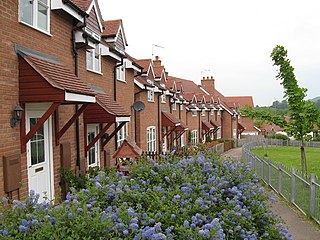
Suckley is a village and civil parish in the Malvern Hills District in the county of Worcestershire, England, close to the border with Herefordshire. The parish includes the hamlets of Suckley Knowl, Suckley Green at SO719532 and Longley Green at SO733503.

Gotherington is a small village north of Bishops Cleeve in Gloucestershire, England. It is surrounded on the north by the villages of Woolstone and Oxenton, and to the south by Woodmancote and Bishop's Cleeve, a very large urban village. Gotherington has a population of around 1,200, while its neighbour, Bishops Cleeve, has a population of 15,000. The populations reduced at the 2011 census to 995 for Gotherington.

Woodmancote is a village and civil parish in the Horsham District of West Sussex, England. The village is 1 mile (1.5 km) southeast of Henfield on the A281 road. It should not be confused with the other West Sussex village of Woodmancote near Chichester.

Old Cleeve is a village 5 miles (8 km) south east of Minehead in the Somerset West and Taunton district of Somerset, England, and also a civil parish. The civil parish of Old Cleeve covers an area of 2,092 hectares and includes the villages of Old Cleeve, Blue Anchor, Roadwater and Washford as well as hamlets such as Bilbrook, Chapel Cleeve, Golsoncott and Leighland Chapel. Approximately half the parish lies within the Exmoor National Park. The remaining half is on the southern edge of Exmoor. The village has been in existence since the early 13th century. The village held its first council meeting in 1711. By the 1720s the village had several churches, in which to meet. The town hall was built in 1727. The first church here was built in 1694, built by the Eastern Christian Society. This church was destroyed in a fire in 1847, and has been rebuilt and restored. In 2011, the population of the parish was 1,672.
Winchcombe was, from 1894 to 1935, a rural district in the Cotswolds area of England. It included parts of two administrative counties: Gloucestershire and Worcestershire.

Bishop's Cleeve railway station was a railway station that served the village of Bishop's Cleeve in Gloucestershire, England.

St Michael & All Angels is the Anglican church in the village of Bishop's Cleeve, just north of Cheltenham in Gloucestershire. Informally the church is known simply as St Michael's.



